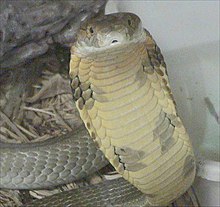 |
King-Cobra |
Behaviour
 |
| A male king cobra extending its hood |
Following envenomation, the king cobra will begin to swallow its struggling prey while its toxins begin the digestion of its victim. King cobras, like all snakes, have flexible jaws. The jaw bones are connected by pliable ligaments, enabling the lower jaw bones to move independently. This allows the king cobra to swallow its prey whole, as well as letting it swallow prey much larger than its head.
King cobras are able to hunt at all times of day, although it is rarely seen at night, leading most herpetologists to classify it as a diurnal species.
Defense
 |
| A king cobra in the St. Louis Zoo with the hood retracted |
When concerned, it rears up the anterior portion (usually one-third) of its body when extending the neck, showing the fangs and hissing loudly. It can be easily irritated by closely approaching objects or sudden movements. When raising its body, the king cobra can still move forward to strike with a long distance and people may misjudge the safe zone. The king cobra may deliver multiple bites in a single attack but adults are known to bite and hold on. In spite of being a highly dangerous snake, it prefers to escape first unless there is no way to go. Since this species is secretive and tends to inhabit less-populated forested regions and dense jungle, it is rarely encountered and seldom comes across humans, except those individuals which are caught for performances and thus many victims bitten by king cobras are actually snake charmers.
If a king cobra encounters a natural predator, such as the mongoose, which has resistance to the neurotoxins, the snake generally tries to flee. If unable to do so, it forms the distinctive cobra hood and emits a hiss, sometimes with feigned closed-mouth strikes. These efforts usually prove to be very effective, especially since it is much more dangerous than other mongoose prey, as well as being much too large for the small mammal to kill with ease.
A good defense against a cobra for anyone who accidentally encounters this snake is to slowly remove a shirt or hat and toss it to the ground while backing away








0 comments:
Post a Comment